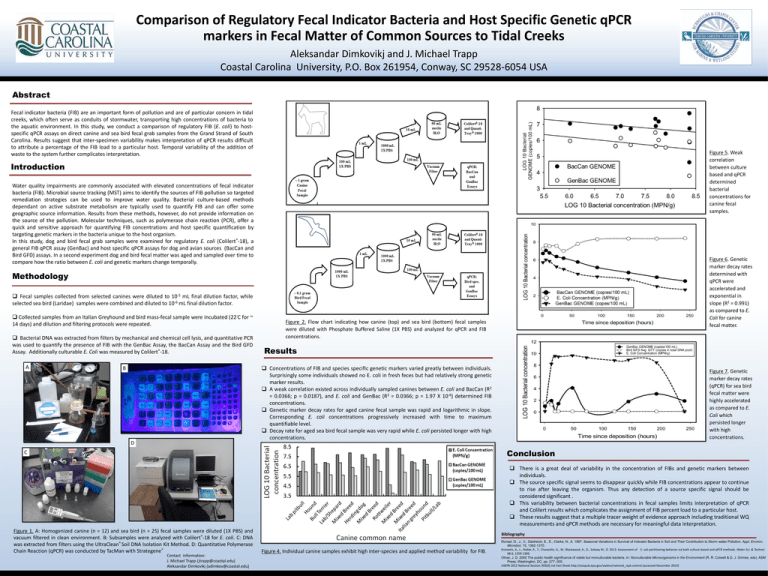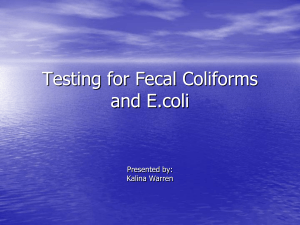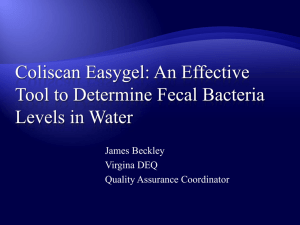Example of a scientific poster
advertisement

Comparison of Regulatory Fecal Indicator Bacteria and Host Specific Genetic qPCR markers in Fecal Matter of Common Sources to Tidal Creeks Aleksandar Dimkovikj and J. Michael Trapp Coastal Carolina University, P.O. Box 261954, Conway, SC 29528-6054 USA Abstract Fecal indicator bacteria (FIB) are an important form of pollution and are of particular concern in tidal creeks, which often serve as conduits of stormwater, transporting high concentrations of bacteria to the aquatic environment. In this study, we conduct a comparison of regulatory FIB (E. coli) to hostspecific qPCR assays on direct canine and sea bird fecal grab samples from the Grand Strand of South Carolina. Results suggest that inter-specimen variability makes interpretation of qPCR results difficult to attribute a percentage of the FIB load to a particular host. Temporal variability of the addition of waste to the system further complicates interpretation. Figure 5. Weak correlation between culture based and qPCR determined bacterial concentrations for canine fecal samples. Introduction Water quality impairments are commonly associated with elevated concentrations of fecal indicator bacteria (FIB). Microbial source tracking (MST) aims to identify the sources of FIB pollution so targeted remediation strategies can be used to improve water quality. Bacterial culture-based methods dependant on active substrate metabolism are typically used to quantify FIB and can offer some geographic source information. Results from these methods, however, do not provide information on the source of the pollution. Molecular techniques, such as polymerase chain reaction (PCR), offer a quick and sensitive approach for quantifying FIB concentrations and host specific quantification by targeting genetic markers in the bacteria unique to the host organism. In this study, dog and bird fecal grab samples were examined for regulatory E. coli (Colilert®-18), a general FIB qPCR assay (GenBac) and host specific qPCR assays for dog and avian sources (BacCan and Bird GFD) assays. In a second experiment dog and bird fecal matter was aged and sampled over time to compare how the ratio between E. coli and genetic markers change temporally. Figure 6. Genetic marker decay rates determined with qPCR were accelerated and exponential in slope (R2 = 0.991) as compared to E. Coli for canine fecal matter. Methodology Fecal samples collected from selected canines were diluted to 10-5 mL final dilution factor, while selected sea bird (Laridae) samples were combined and diluted to 10-6 mL final dilution factor. Collected samples from an Italian Greyhound and bird mass-fecal sample were incubated (22◦C for ~ 14 days) and dilution and filtering protocols were repeated. Bacterial DNA was extracted from filters by mechanical and chemical cell lysis, and quantitative PCR was used to quantify the presence of FIB with the GenBac Assay, the BacCan Assay and the Bird GFD Assay. Additionally culturable E. Coli was measured by Colilert®-18. A Figure 2. Flow chart indicating how canine (top) and sea bird (bottom) fecal samples were diluted with Phosphate Buffered Saline (1X PBS) and analyzed for qPCR and FIB concentrations. Results Concentrations of FIB and species specific genetic markers varied greatly between individuals. Surprisingly some individuals showed no E. coli in fresh feces but had relatively strong genetic marker results. A weak correlation existed across individually sampled canines between E. coli and BacCan (R2 = 0.0366; p = 0.0187), and E. coli and GenBac (R2 = 0.0366; p = 1.97 X 10-6) determined FIB concentrations. Genetic marker decay rates for aged canine fecal sample was rapid and logarithmic in slope. Corresponding E. coli concentrations progressively increased with time to maximum quantifiable level. Decay rate for aged sea bird fecal sample was very rapid while E. coli persisted longer with high concentrations. B D Figure 7. Genetic marker decay rates (qPCR) for sea bird fecal matter were highly accelerated as compared to E. Coli which persisted longer with high concentrations. Conclusion C There is a great deal of variability in the concentration of FIBs and genetic markers between individuals. The source specific signal seems to disappear quickly while FIB concentrations appear to continue to rise after leaving the organism. Thus any detection of a source specific signal should be considered significant . This variability between bacterial concentrations in fecal samples limits interpretation of qPCR and Colilert results which complicates the assignment of FIB percent load to a particular host. These results suggest that a multiple tracer weight of evidence approach including traditional WQ measurements and qPCR methods are necessary for meaningful data interpretation. Figure 1. A: Homogenized canine (n = 12) and sea bird (n = 25) fecal samples were diluted (1X PBS) and vacuum filtered in clean environment. B: Subsamples were analyzed with Colilert®-18 for E. coli. C: DNA was extracted from filters using the UltraClean® Soil DNA Isolation Kit Method. D: Quantitative Polymerase Chain Reaction (qPCR) was conducted by TacMan with Strategene® Contact information: J. Michael Trapp (jtrapp@coastal.edu) Aleksandar Dimkovikj (adimkov@coastal.edu) Bibliography Figure 4. Individual canine samples exhibit high inter-species and applied method variability for FIB. Donsel, D., J., V., Geldreich, E., E., Clarke, N., A. 1967. Seasonal Variations in Survival of Indicator Bacteria in Soil and Their Contribution to Storm-water Pollution. Appl. Environ. Microbiol. 15, 1362-1370. Krometis, A., L., Noble, R., T., Characklis, G., W., Blackwood, A., D., Sobsey M., D. 2013. Assessment of E. coli partitioning behavior via both culture-based and qPCR methods. Water Sci. & Technol. 68.6, 1359-1369. Oliver, J. D. 2000 The public health significance of viable but nonculturable bacteria. In: Nonculturable Microorganisms in the Environment (R. R. Colwell & D. J. Grimes, eds). ASM Press, Washington, DC, pp. 277–300. USEPA 2012 National Section 303(d) List Fact Sheet.http://oaspub.epa.gov/waters/national_rept.control (accessed December 2013)











